|
Day Five: February 26, 1997: Sailing from Union Island
to Tobago Cays
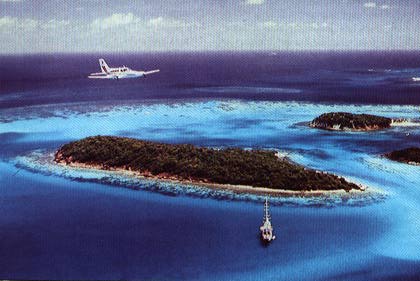
We were up early this morning to feed everyone
promptly, and then make preparations to sail to the Tobago Cays (illustrated
right). Green watch was assigned to raise the anchor, this would become
their typical duty, as they were the only ones really capable of it. Red
watch was assigned to raising the the main Staysail, and the Inner jib,
this became their typical detail, as they always seemed to find themselves
battling squalls. The sail from Union Island to the Tobago Cays took about
two hours, as we arrived, we turned a lot of heads from the other anchored
boats. The Fair Jeanne is a Hermaphraditic Brigantine, which means it only
has three square sails, if it had a fourth, then it would be a true Brigantine.
Captain Mulder has a flair for being flamboyant, typically sailing into
harbours under sail if possible. The Fair Jeanne is an amazing ship when
her sails are set properly, and a properly trained crew, she the ability
to zig and zag through the water upon the captain's command.
As we came into the Tobago Cays under sail, everyone
on a ship anchored in the harbour stopped what they were doing, and took
up a good vantage point to watch us come in. Green watch was delegated
to lower the anchor, and Red and White watch lowered the sails.
We stuck close to this island shown inset; Baradal. From
here, we set out early to explore the forereef, and take a general tour
through and around the reef.
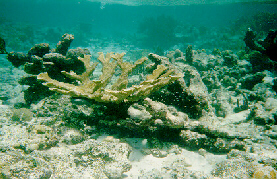
We paired up in the buddy system to make sure no one got
lost. These reefs were quite a beautiful sight, there were tons of fish,
marine organisms and fire coral (millipora).
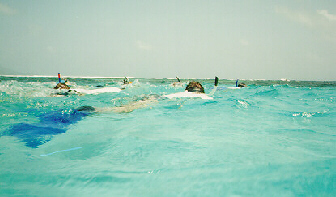 We
swam as a group initially looking at the different sections of the reef.
We paired up while swimming, for safety. We were able to swim anywhere
we wished, as long as we stayed with our buddy. We explored in our own
groups, then headed through the reefcrest. This was a difficult passage,
the reef is at its highest growth point here, as well, the crashing waves
change the depth of the water, and often throw you down against the coral.
When getting bounced off the coral, one of two things occurs, you get cut,
or if you touch fire coral you get a welt whcih will stings for days. We
swam as a group initially looking at the different sections of the reef.
We paired up while swimming, for safety. We were able to swim anywhere
we wished, as long as we stayed with our buddy. We explored in our own
groups, then headed through the reefcrest. This was a difficult passage,
the reef is at its highest growth point here, as well, the crashing waves
change the depth of the water, and often throw you down against the coral.
When getting bounced off the coral, one of two things occurs, you get cut,
or if you touch fire coral you get a welt whcih will stings for days.
We all made it to the forereef with relative ease, there
were channels where we could swim to get through. On the forereef, the
shelf quickly dropped off, and we spent about half an hour swimming around
until the wave action got too brisk and we had to return back within the
protection of the reef. Back inside the reefcrest we were allowed to roam
again. Chris and Matt headed off on their own, they saw a big fish and
began to chase it. Chris had an underwater camera and wanted to get a good
picture of it, it was quick and, it led them into the shallow reef where
he gave up. (Later Chris and Matt found out that it was a Barracuda, it
might have made a quick lunch of them, if they had followed it in.)
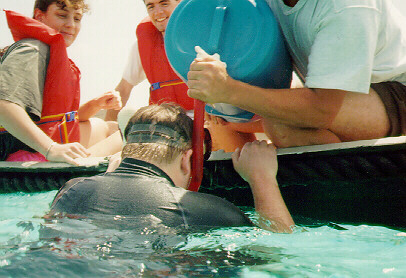 Swallowing
sea water, is one of the drawbacks of the caribbean, but a trade-off for
the beautiful scenary. The whaler from the ship came out to releive us
with some juice. Most of us took it the conventional way, but one of our
group, Matt, liked it from the snorkel. Swallowing
sea water, is one of the drawbacks of the caribbean, but a trade-off for
the beautiful scenary. The whaler from the ship came out to releive us
with some juice. Most of us took it the conventional way, but one of our
group, Matt, liked it from the snorkel.
We returnted to the boat at noon, to eat and organize
ourselves for our afternoon activities. There was no set structure for
the afternoon, we had free time if we wanted, but most people choose to
participate in something. A large group took the dingy ashore to Baradal,
and hiked the island, trying to determine its origin. While a small group
(Tim, Andre, Sean and the Captain) went scuba diving. Chris, Todd, and
Matt began their research project of a transect from the shore of Baradal
to the forereef.
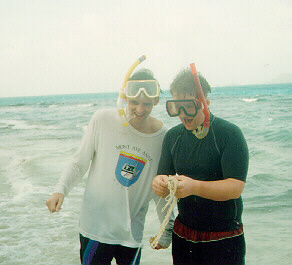 For
their research project, they were to take a sand sample, record observations,
make assessment, and collect any pertinent specimens, every 50m. So before
heading out, they decided that the best way to measure 50 m was to take
a twine which was 50m, and stretch it out. As they were doing this dry,
they had problems winding the twine. As you might imagine, once the twine
got wet, the problems increased 10 fold. Inset is a picture on the shore
of Baradal of Matt and Todd trying to untangle the wet and knotted twine. For
their research project, they were to take a sand sample, record observations,
make assessment, and collect any pertinent specimens, every 50m. So before
heading out, they decided that the best way to measure 50 m was to take
a twine which was 50m, and stretch it out. As they were doing this dry,
they had problems winding the twine. As you might imagine, once the twine
got wet, the problems increased 10 fold. Inset is a picture on the shore
of Baradal of Matt and Todd trying to untangle the wet and knotted twine.
The shore of Baradal had beachrock similar to Barabados,
but it was uniquely different. The vegetation on Baradal was lush with
huge plants right down to the beach line. Most of the island was composed
of mafic volcanic rock. The beach sand was a conglomerate mixture of all
sizes of sand, pebbles and cobbles.
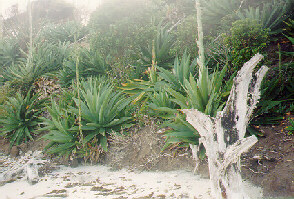
We returned to the ship after a lot of swimming, snorkelling
and hiking, we were tired and hungry. There was plenty of food as always.
We were anchored in the harbour tonight, spending one more day in the Tobago
Cays, so there was only anchor watches for tonight. Tomorrow would be much
of the same, so most of us went to bed early, to get a good night's sleep,
and be well rested for both our anchor watches and tomorrow's events.
|
|